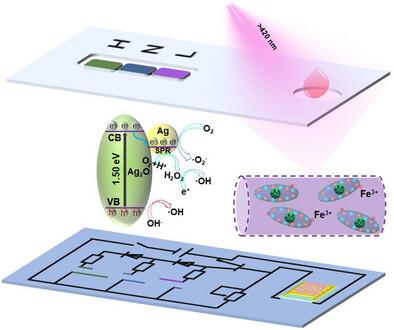Photoelectrochemical Nanofiber Ferritin Sensor with Integrated “Migrating-Destructing-Detecting” Capability
IF 19
1区 材料科学
Q1 CHEMISTRY, MULTIDISCIPLINARY
引用次数: 0
Abstract
Conventional photoelectrochemical (PEC) protein sensors typically rely on steric hindrance to reduce photoelectric signals; however, this photoelectron-reducing model inherently limits protein accumulation at the sensing interface, thereby reducing detection sensitivity. By contrast, this study introduces an ultrasensitive PEC nanofiber-based ferritin sensor that employs a signal-enhanced mechanism by constructing numerous Ag2O/Ag heterojunction nanoreactors along the nanofibers. Hydrophilic closed-loop nanostructures simultaneously integrate the migrating-destructing-detecting methods of ferritin within a single nanoreactor, resulting in enhanced photoelectric signals. This PEC nanofiber ferritin sensor exhibits a wide linear range of 10−8–102 mg mL−1 and superhigh sensitivity of 5 pg mL−1. Building on this platform, an ion signal-enhanced response device is developed to facilitate rapid and precise monitoring of proteins across low, normal, and high ferritin levels, enabling precise assessment under various pathological conditions. These findings establish a robust framework for ferritin detection using PEC protein sensing technologies.

具有“迁移-破坏-检测”一体化功能的光电化学纳米纤维铁蛋白传感器
传统的光电化学(PEC)蛋白质传感器通常依靠位阻来减小光电信号;然而,这种光电子还原模型固有地限制了蛋白质在传感界面的积累,从而降低了检测灵敏度。相比之下,本研究介绍了一种基于PEC纳米纤维的超灵敏铁蛋白传感器,该传感器通过沿纳米纤维构建大量Ag2O/Ag异质结纳米反应器,采用信号增强机制。亲水闭环纳米结构在单个纳米反应器内同时集成了铁蛋白的迁移-破坏-检测方法,从而增强了光电信号。该PEC纳米纤维铁蛋白传感器具有10−8 ~ 102 mg mL−1的宽线性范围和5 pg mL−1的超高灵敏度。在此平台上,开发了离子信号增强响应装置,以方便快速准确地监测低、正常和高铁蛋白水平的蛋白质,从而在各种病理条件下进行精确评估。这些发现为使用PEC蛋白传感技术检测铁蛋白建立了一个强大的框架。
本文章由计算机程序翻译,如有差异,请以英文原文为准。
求助全文
约1分钟内获得全文
求助全文
来源期刊

Advanced Functional Materials
工程技术-材料科学:综合
CiteScore
29.50
自引率
4.20%
发文量
2086
审稿时长
2.1 months
期刊介绍:
Firmly established as a top-tier materials science journal, Advanced Functional Materials reports breakthrough research in all aspects of materials science, including nanotechnology, chemistry, physics, and biology every week.
Advanced Functional Materials is known for its rapid and fair peer review, quality content, and high impact, making it the first choice of the international materials science community.
 求助内容:
求助内容: 应助结果提醒方式:
应助结果提醒方式:


